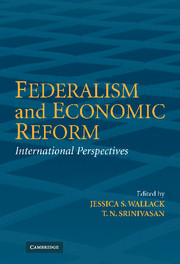Book contents
- Frontmatter
- Contents
- List of Contributors
- Acknowledgments
- 1 Analyzing Federalism: Stylized Models and the Political Economy Reality
- 2 Federalism in Argentina and the Reforms of the 1990s
- 3 Australia: Central Fiscal Dominance, Collaborative Federalism, and Economic Reform
- 4 The Brazilian Federation: Facts, Challenges, and Perspectives
- 5 Changing with the Times: Success, Failure, and Inertia in Canadian Federal Arrangements, 1945–2002
- 6 Fiscal Federalism and Economic Reform in China
- 7 Indian Federalism, Economic Reform, and Globalization
- 8 Mexico's Decentralization at a Crossroads
- 9 Transfer Dependence and Regional Disparities in Nigerian Federalism
- 10 Conclusions and Lessons for Further Study
- Index
- References
6 - Fiscal Federalism and Economic Reform in China
Published online by Cambridge University Press: 25 July 2009
- Frontmatter
- Contents
- List of Contributors
- Acknowledgments
- 1 Analyzing Federalism: Stylized Models and the Political Economy Reality
- 2 Federalism in Argentina and the Reforms of the 1990s
- 3 Australia: Central Fiscal Dominance, Collaborative Federalism, and Economic Reform
- 4 The Brazilian Federation: Facts, Challenges, and Perspectives
- 5 Changing with the Times: Success, Failure, and Inertia in Canadian Federal Arrangements, 1945–2002
- 6 Fiscal Federalism and Economic Reform in China
- 7 Indian Federalism, Economic Reform, and Globalization
- 8 Mexico's Decentralization at a Crossroads
- 9 Transfer Dependence and Regional Disparities in Nigerian Federalism
- 10 Conclusions and Lessons for Further Study
- Index
- References
Summary
INTRODUCTION
Because of history, size, and economic potential China is a force to reckon with. It is a nation of 9.6 million square kilometers populated by 1.26 billion people with a varied geography: Traveling from west to east (Figure 6.1) one starts with the vast dry areas, moves to the mountains, valleys, and higher altitudes of the center, and ends up in the more temperate coastal regions, which have more rain, lower altitudes, and better communication and transportation systems. A main theme of this chapter is that, in great part owing to geography, but also owing to overt government policies, wealth and economic well-being tend to increase monotonically from west to east. That reality significantly conditions the past, present, and future of fiscal federalism in China.
A standard grouping of China's provinces is used in Table 6.1 to describe the economic geography. The Northern Region includes the large and rich cities of Beijing and Tianjin. These two cities, together with Shanghai in the Eastern Region and Chongqing in the Southwest Region, are granted provincial status, much as is the case for Moscow and St. Petersburg in Russia. The Northern Region also contains the relatively poor province of Inner Mongolia. The Northeast Region, also known as Manchuria, contains several relatively rich provinces with a long tradition of manufacturing dating back to Japan's occupation of this area in the first part of the twentieth century.
- Type
- Chapter
- Information
- Federalism and Economic ReformInternational Perspectives, pp. 249 - 300Publisher: Cambridge University PressPrint publication year: 2006
References
- 10
- Cited by



